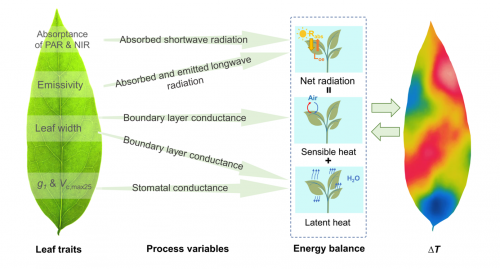Leaf thermoregulation and consequent leaf-to-air temperature difference (ΔT) are tightly linked to plant metabolic rates and health, and are important for accurate modeling of plant physiological responses to climate change. It has been widely observed that leaf thermoregulation can vary largely within a day and across plant species. However, the underlying mechanism of what drives such large thermoregulation variation is unknown and lacks comprehensive evaluations of biotic controls on ΔT dynamics.
An international team of terrestrial scientists from Hong Kong, Mainland China, South Korea, and Canada, led by Dr Jin Wu (Assistant Professor from the School of Biological Sciences, HKU), including Mr. Zhengfei Guo (first author of the work; Dr. Wu’s PhD student), Zhengbing Yan (second author; postdoc of Dr. Wu’s lab), and Mr. Bartosz Majcher (third author; PhD student of Dr Louise Ashton’s lab), have developed a new theory-based modeling framework that allows us to not only understand the role of biotic factors in leaf thermoregulation, but also improve simulations of diverse leaf thermoregulation strategies across species and physiological responses to climate change. This modeling framework is named as a trait-based leaf energy balance model, which relies on an assumption that plant species can be characterized by a set of plant traits. Thus, when integrating the plant ecophysiology theory (that describes how leaf photosynthesis and transpiration respond to environment) with leaf energy balance equations (that serves as a conventional way for modeling leaf temperature), we were able to build up an integrated, trait-based leaf energy balance model, with six measurable leaf traits: (Fig. 1), i.e., emissivity, visible and near-infrared light absorptance, size, maximum carboxylation rate scaled to 25 °C (Vc,max25), and Medlyn type stomatal slope (g1).
With this newly developed model, we first performed sensitivity analysis to quantify to what extent leaf traits mediate ΔT variability. We then quantified the relative role of each trait for ΔT, and explored their relative importance across the diel course. We last evaluated the modeling results with in-situ observations collected from both temperate and tropical forests. Our results show that: (1) leaf traits largely mediate ΔT variability, with noon-time ΔT of a summer clear-sky day varying from -3 °C to 12 °C; (2) leaf size, Vc,max25, and g1 are the three most important traits, and their relative importance in ΔT regulation varies strongly across the diel course (Fig. 2); (3) modeled trait-ΔT relationships strongly agree with field observations. Collectively, this study improves quantifications and process understanding of biotic controls of ΔT variability, offering a trait-based representation of leaf energy balance that can be incorporated into terrestrial biosphere models for improved simulations of terrestrial ecosystem physiological responses to climate change.
“Unlike the conventional approach that is used to model or interpret leaf thermoregulation, our trait-based approaches allow us to use measurable and ecologically meaningful properties of leaves to understand the mechanism underlying dynamic biotic controls of leaf thermoregulation across both space and time,” said Dr. Jin Wu. “This trait-based modeling framework with field validation suggests the great potential to be implemented in large-scale terrestrial biosphere models for improving plant ecophysiology modeling across diverse abiotic and biotic environments,” complemented by Dr. Zhengbing Yan. “Our study not only demonstrates how, but also explains why the importance of specific leaf traits on thermoregulation changes throughout the day and night. The observed pattern (Fig. 2) was consistent across biomes and present in dry tropical forests, rainforests, and temperate forests. It underlines the importance of including such diurnal variability in models of leaf temperature across the globe as well as points out a caveat that focusing on a specific time of day in studies of leaf temperature can result in inaccurate estimations of contribution of certain traits” added Mr. Bartosz Majcher. “This work also raises real-world awareness, as leaf temperature has often been used as a natural way for plant health monitoring, while our observed large biotic-associated leaf temperature variation suggests the precision agriculture or plant health monitoring should also account for the effects associated with leaf internal properties” summarised Mr. Zhengfei Guo.

Figure 1. Theoretical pathways connecting leaf traits and associated process variables within the leaf energy balance equation that infers leaf-to-air temperature difference (∆T). ∆T is determined by three energy fluxes (i.e. net radiation, sensible heat, and latent heat), which are further connected with the six leaf traits, including absorptance of PAR (αPAR, 400-700nm), absorptance of NIR (700-2500nm), emissivity, leaf width, Medlyn-type stomatal slope (g1), and maximum carboxylation capacity (Vc,max25).

Figure. 2. Diel variation in traits’ relative contribution on regulating the ΔT variability. nighttime is defined as the period when PAR is less than 10 μmol m − 2 s − 1. The dashed lines in this figure indicate the time points when net radiation flux (Rn) is equal to latent heat flux (λE) during which leaf temperature is equal to air temperature and there is no sensible heat exchange. The pattern is consistent for the three forest sites: (a) a temperate deciduous forest of Mt. Changbai, China (CB), (b) a tropical rainforest of Xishuangbanna, China (XSBN), and (c) a Caatinga woodland forest near Petrolina, Brazil (PE).
The findings were recently published in Agricultural Forest and Meteorology.
Journal paper can be accessed from here:
https://www.sciencedirect.com/science/article/abs/pii/S0168192322000211

